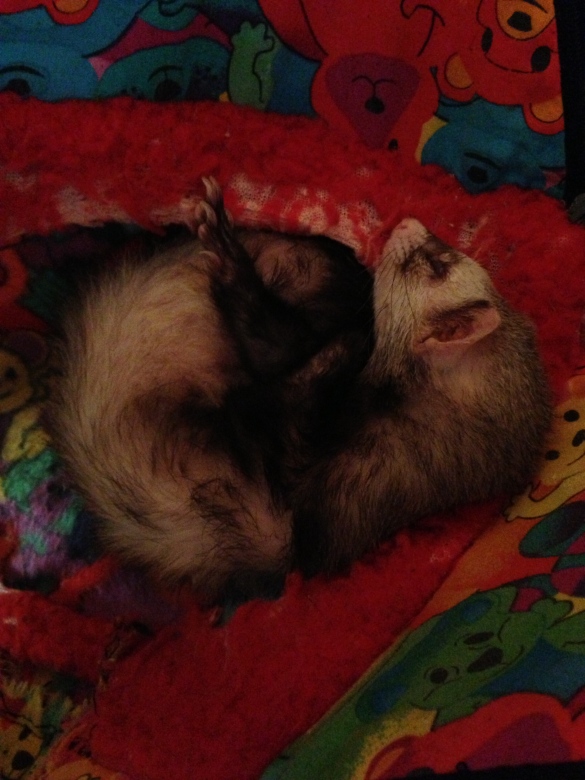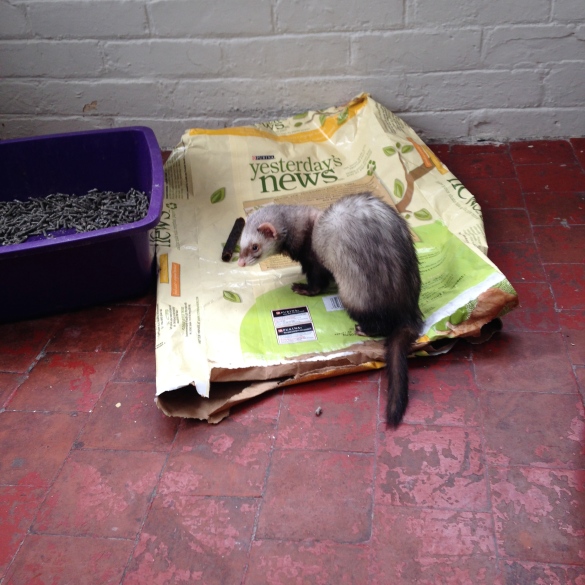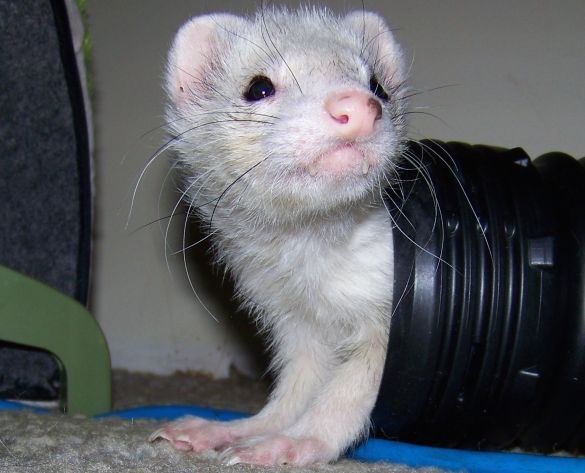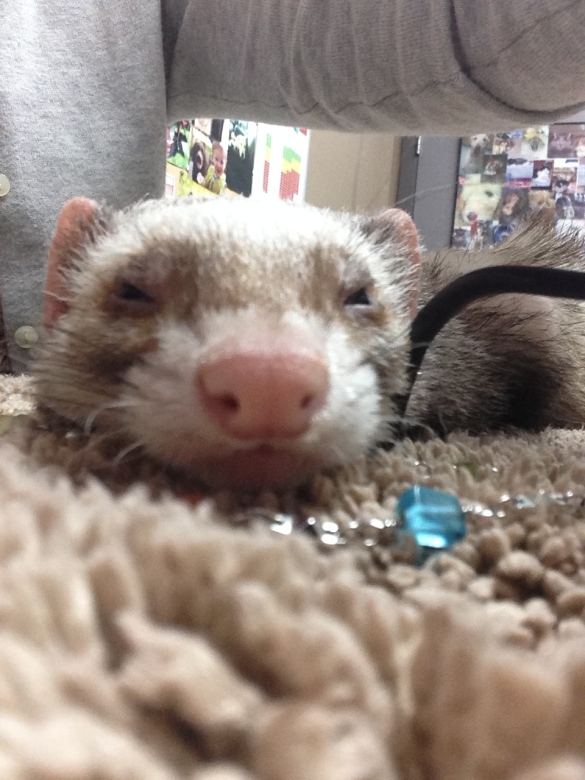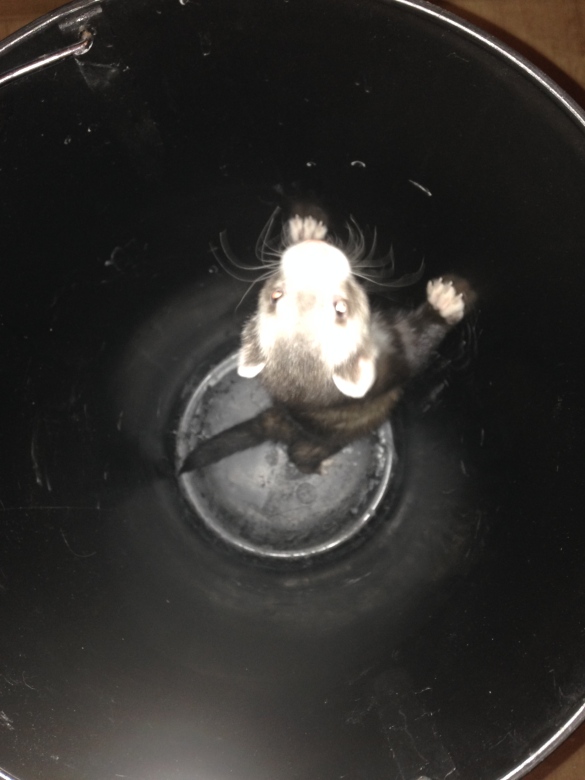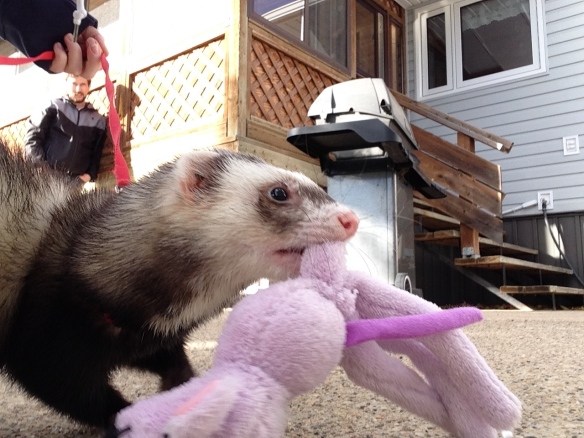Before bringing home your new carpet shark it is good to make sure you have everything prepared as (1) it will allow you to spend as much time with them as possible upon arrival and (2) some things are very dangerous to our little monsters.
These are must-haves for any little furry to live safely and comfortably with you;
1. Cage
When you are not around to supervise your ferret the safest place for them is in a ferret friendly cage. It is recommended having the cage setup in a room where you spend your time most. This way the ferret will always feel a part of the family.
A ferrets cage should be chosen based on their life style. If your ferret spends most it’s time free-range, smaller cages just for sleeping will suffice. If you are unable to have your ferret out for more than a few hours, it is recommended that you acquire something a little larger (see here for example).
Ferrets do not live in aquariums, this will cause more odor, they need lots of air flow which will help keep the animal smell down.
Ferrets should never have wood chips for bedding, they like to eat everything and as wood is sharp this can cause internal injuries. Wood chips may also cause respiratory problems or liver disease.
You can find ferret specific cages at almost any pet store (new or used), online, a ferret shelter or pet supply store, etc. Metal is usually the norm as if created out of wood it may be harder to clean and begin to smell after time.
If you decide to get a cage that has a wire bottom, protect your monster’s feet by placing a carpet, thick blanket or piece of linoleum.
** The MFA has a selection of pre owned ferret cages for sale **
There are many options out there for housing, simple single levels, bi levels, multi levels. Just keep in mind when shopping; ample size, good ventilation, small openings between wire and secure doors.
Ferrets are escape artists – if they see you push a door closed they may try to push it open. Make sure you secure all opens and have a sturdy cage. I had to purchase a lock for one of my cages as my little Bandit (after watching once) would grab the door with her teeth and shake it until it opened.
2. Bedding / Hammock
Ferrets love to tunnel in blankets, snuggle up in their bedding and curl up in a hammock. There is a huge selection of ferret specific options along with small animals or even cat products. As each ferret has their own personality find out what they like best and go from there. The only thing to note is stay away from Cat Nip products, this is not ferret friendly.
You can also DIY bedding and toys, just make sure it’s baby safe, as ferrets and babies both like to eat things they shouldn’t (i.e. no buttons or sharp pieces).
** The MFA has a great selection of bedding for sale **
Simple items around the house that you can use include; old towels, baby blankets, old sweatshirts, pillow cases.
Have an old pair of jeans? Cut the legs off and you have yourself a brand new ferret tunnel.
3. Food and Water containers
It is recommended to use heavy duty plastic or ceramic dishes. Ferrets tend to enjoy making huge messes and as much noise as possible.
For water I use both a ceramic dish full and two large water bottles, my boys Turnip & Radish like the bottles while Bandit would only drink from the dish. Turnip also enjoyed bathing in the dish, so always make sure to change often.
It is nice to have a bottle that holds at least 15 ounces, hung from the outside of the cage the monsters are unable to fiddle with. Changed daily or every second day to keep the water nice and fresh.
A great idea is to put the food on one level and the water on another while possible, so they have to get exercise in order to get both. Although if you happen to have an old or ill ferret you may want to keep them closer together. Another thing to note is ferrets, like us, prefer having food separated from their washroom, so as able keep the food and water on a different level than their litter box.
Please make sure that you don’t put the food dish too high up or too low on the cage when using ones that clip to the sides, as well as the water bottle so they cannot reach it. You don’t want them having to strain to get either their food or water.
Finally if you have a ferret nation cage that is about 4 feet in the air, placing heavy dishes at the top is not always best – ferrets like to push things off ledges. Depending how many ferrets you have in one cage consider having more than one food and water containers.
4. Litter and Litter box Selection
The type of pan to get depends entirely on the ferret you are getting, along with the temperament, gender and age is a factor.
If you are getting a kit you don’t want anything that has too high of sides as their legs are quite short. As well with older, sick and injured ferrets, too high can prevent them from using the litter pan.
When adopting an adult ferret in perfect health you generally would want to get one with higher sides that of course fits well inside the cage, but remember ferrets have personalities – so before purchasing multiple see what they like.
Lastly I have noticed with my male ferrets they poop with their bums as high in the air as possible, while my girl would keep her arms on the edge of the pan and squat. For the males I had a high back corner pan, for my girl I would have a lower square pan.
The shelter in Winnipeg actually uses 2 pans the bottom one is bolted to the cage while the top one isn’t. It fits right inside the bottom one so you can remove it to clean.
You will also want to get additional pans to place in different areas of your home as they do go outside the cage when it is their time out for play. The best way to determine where to put these pans is to watch where your ferret decides to go and of course that is where you would put one.
Litter do’s and don’ts..
As you hopefully are aware ferrets are diggers and burrowers, with that please DO NOT get any; clay, clumping or flushable litter. These options tend to be quite dusty, even those that claim they are not and can actually cause respitory problems in your little one. As stated before do not use wood chips or cedar shavings as these do the same.
The litter I highly recommend is a pelleted litter. Natural of course without any added scents. These can be made of plant fibres or recycled newspaper. Lakewood Industries Premium Wood Pellets are what the shelter uses, they manufacture out of Ontario and readily available in Canada. I have used Yesterday’s News in the past as well.
5. Grooming
Bathing – Ferrets can be bathed every 2-3 months. This helps reduce the musk smell (although an important part of reducing the smell is keeping the ferret’s bedding clean and it’s ears clean). There are now several ferret-specific shampoos available, kitten shampoos and dry shampoos.
Nail Clippers – They need their nails clipped every week and a half to two weeks, be careful to not cut into the quick.
Ear Cleaning Solution – Earwax buildup is smelly and can lead to health problems if not cleaned. Any ear cleaning solution for cats or dogs will work, Saline solution for contacts also works well. Never stick a q-tip inside the ear canal.
6. Cage Accessories and Toys
Ferrets will entertain themselves with anything they can find. Ferret-safe toys don’t have parts they could accidentally chew off and swallow. Always monitor all toys for damage, as accidentally swallowed pieces of things can lead to intestinal blockages.
You are the best toy of all spend time playing with your ferret. Later we will post of game ideas and DIY toys.
7. Harness, Leash and Carriers
Ferrets can slip out of a collar easily which means you will want a harness that goes both around the neck and front legs. There are two dominate options on the market (option 1 & option 2 – I use option 1).
You want to have it snuggly fitting but still loose enough to fit a finger between strap and ferret. It is never a good idea to keep a collar or harness on your ferret for prolonged periods of time, especially unsupervised and don’t forget to adjust them as your ferret grows (or possibly loses weight).
A portable carrier should be used for bringing your ferret to the veterinarian or other outings. It can also serve as a training aid by being used as a time-out cage for a misbehaving ferret. Never use a carrying cage as a permanent home for your ferret as they’re too small.
8. Treats
Please remember that treats are just that, small rewards, they should not be a large part of your ferret’s diet. They are good for bonding with your ferret and rewarding good behaviour, as well as learning tricks. Later we will update with ferret friendly recipes!

